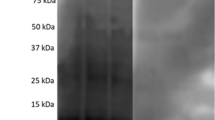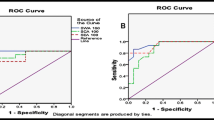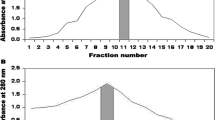Abstract
Schistosoma mansoni is a parasitic trematode of the portal–mesenteric veins with a closed-end intestine. Adult worms regurgitate their intestinal content after digestion, together with constituents of the lining gut. Some of these molecules circulate in the blood and are antigenic. We obtain a “vomit” preparation and preliminary evaluate its biochemical composition and antigenic capacity. The “vomit” preparation was obtained after changes in temperature and solutions of incubation of adult worms between 4 and 37°C. Supernatant was assayed for protein, carbohydrate concentration and enzymatic activities associated to the intestine and to the worm tegument. The antigenicity of the product was evaluated using Western blot (WB) analysis against sera of experimentally infected mice, before and after drug cure, sera from people infected with S. mansoni and from individuals infected with other parasitoses. More carbohydrate than protein was detected in the preparations. Cysteine proteinase (CP), N-acetyl-β-d-glucosaminidase and alkaline phosphatase activities were detected. The latter enzyme activity is a marker of the tegument, suggesting that in spite of careful conditions used to avoid the presence of tegumental material, manipulation of the worms always resulted in the release of tegumental molecules. Cationic exchange chromatography was useful to separate various components of this “vomit” preparation, particularly enzymes responsible for CP activity. Two highly immunogenic and specific duplets were observed in the WB analysis, 31/32- and 38/40-kDa components, the former probably referring to the intestinal CPs Sm31/Sm32. None of the two duplets disappeared after successful chemotherapy during the time of evaluation in mice or humans.






Similar content being viewed by others
References
Bogitsh BJ (1989) Observations on digestion in schistosomes or “blood and guts”. Trans Am Microsc Soc 108:1–5
Bogitsh BJ, Shannon WA (1971) Cytochemical and biochemical observations on the digestive tract of digenetic trematodes. Exp Parasitol 29:337–347
Bogitsh BJ, Dalton JP, Brady CP, Brindley PJ (2001) Gut associated immunolocalization of the Schistosoma mansoni cysteine proteases, SmCL1 and SmCL2. J Parasitol 87:237–241
Bradford MM (1976) A rapid and sensitive method for the quantitation of microgram quantities of protein utilizing the principle of protein dye binding. Anal Biochem 72:248–254
Brindley PJ, Kalinna BH, Dalton JP, Day SR, Wong JYM, Smythe ML, McManus DP (1997) Proteolytic degradation of host hemoglobin by schistosomes. Mol Biochem Parasitol 89:1–9
Caffrey CR, Ruppel A (1997) Cathepsin B-like activity predominates over cathepsin L-like activity in adult Schistosoma mansoni and S. japonicum. Parasitol Res 83:632–635
Caffrey CR, Rheinberg CE, Mone H, Jourdane J, Li YL, Ruppel A (1997) Schistosoma japonicum, S. mansoni, S. haematobium, S. intercalatum, and S. rodhaini: cysteine-class cathepsin activities in the vomitus of adult worms. Parasitol Res 83:37–41
Cesari IM, Auriault C, Capron A (1983) Aminopeptidase activity in adult Schistosoma mansoni. J Parasitol 69:280–284
Cesari IM, Bouty I, Bout D, De Noya BA, Hoebeke J (1992) Parasite enzymes as a tool to investigate immune responses. Mem Inst Oswaldo Cruz 87(Suppl 4):55–65
Cesari IM, Ballen DE, Perrone T, Oriol O, Hoebeke J, Bout D (2000) Enzyme activities in Schistosoma mansoni soluble egg antigen. J Parasitol 86:1137–40
Chappell CL, Dresden MH (1986) Schistosoma mansoni: proteinase activity of hemoglobinase from the digestive tract of adult worms. Exp Parasitol 61:160–167
Chappel CL, Dresden MH (1988) Antibody response to a purified parasite proteinase (SMw 32) in Schistosoma mansoni infected mice. Am J Trop Med Hyg 39:66–73
De Jonge N, Gryseels B, Hilberath GW, Polderman AM, Deelder AM (1988) Detection of circulating anodic antigen by ELISA for seroepidemiology of schistosomiasis mansoni. Trans R Soc Trop Med Hyg 82:591–594
De Jonge N, De Caluwe P, Hilberath GW, Krijger FW, Polderman AM, Deelder AM (1989) Circulating anodic antigen levels in serum before and after chemotherapy with Praziquantel in schistosomiasis mansoni. Trans R Soc Trop Med Hyg 83:368–372
De Jonge N, Kremsner PG, Krijger FW, Schommer G, Filie YE, Kornelis D, Van Zeyl RJ, Van Dam GJ, Feldmeier H, Deelder AM (1990) Detection of the schistosome circulating cathodic antigen by enzyme immunoassay using biotinylated monoclonal antibodies. Trans R Soc Trop Med Hyg 84:815–818
De Jonge N, Rabello ALT, Krijger FW, Kremsner PG, Rocha RS, Katz N, Deelder AM (1991) Levels of schistosome circulating anodic and cathodic antigens in serum of schistosomiasis patients from Brazil. Trans R Soc Trop Med Hyg 85:756–759
Deelder AM, Klappe HTM, Van Den Aardeweg GJMJ, Van Meerbeke EHEM (1976) Schistosoma mansoni: demonstration of two circulating antigens in infected hamsters. Exp Parasitol 40:189–197
Deelder AM, Van Dam GJ, Kornelis D, Fillié YE, Vanzeyl JM (1996) Schistosoma: analysis of monoclonal antibodies reactive with the circulating antigens CAA and CCA. Parasitology 112:21–35
Delgado VS, Suarez DP, Cesari IM, Incani RN (1992) Experimental chemotherapy of Schistosoma mansoni with Praziquantel and Oxamniquine: differential effect of single or combined formulations of drugs on various strains and on both sexes of the parasite. Parasitol Res 76:648–654
Dubois M, Gills KA, Hamilton JK, Rebers PA, Smith F (1956) Colorimetric method for determination of sugars and related substances. Anal Chem 28:350–356
El-Sayed L, Ghoneim H, Demian SR, El-Sayed MH, Tawfik NM, Sakr I, Abou-Basha LM, Renganathan A, Klinkert MQ, Abou-Rawash N (1998) Diagnostic significance of Schistosoma mansoni proteins Sm31 and Sm32 in human schistosomiasis in an endemic area in Egypt. Trop Med Int Health 3:721–727
Fallon PG, Coopera RO, Probert AJ, Doenhoff MJ (1992) Immune-dependent chemotherapy of schistosomiasis. Parasitology 105:S41–S48
Fallon PG, Fookes RE, Wharton GA (1996) Temporal differences in Praziquantel and Oxamniquine-induced tegumental damage to adult Schistosoma mansoni: implications for drug–antibody synergy. Parasitology 112:47–58
Feldmeier H, Nogueira-Queiroz JA, Peixoto-Queiroz MA, Doehring E, Dessaint JP, De Alencar JE, Dafalla AA, Capron A (1986) Detection and quantification of circulating antigen in schistosomiasis by monoclonal antibody II. The quantification of circulating antigens in human schistosomiasis mansoni and haematobium: relationship to intensity of infection and disease status. Clin Exp Immunol 65:232–243
García N, Istúriz G, Aular S, Incani RN (2006) The efficacy of human schistosomicide treatment may depend on the rate of transmission. Parasitol Res 98:545–549
Gómez YM, Pereira VRA, Nakasawa M, Montarroyos U, Souza WV, Abath FCG (2002) Antibody isotype responses to egg antigens in humans chronic schistosomiasis mansoni before and after treatment. Mem Inst Oswaldo Cruz 97(Suppl 1):111–112
Halton DW (1997) Nutritional adaptations to parasitism within the Platyhelminthes. Int J Parasitol 27:693–704
Hassan MM, Badawi MA, Strand M (1992) Circulating schistosomal antigen in diagnosis and assessment of cure in individuals infected with Schistosoma mansoni. Am J Trop Med Hyg 46:737–744
Laemmli UK (1970) Cleavage of structural proteins during the assembly of the head of the bacteriophage T4. Nature 227:680–685
Lawrence JD (1973) The ingestion of red blood cells by Schistosoma mansoni. J Parasitol 59:60–63
McCarthy E, Stack C, Donnelly SM, Doyle S, Mann VM, Brindley PJ, Stewart M, Day TA, Maule AG, Dalton JP (2004) Leucine aminopeptidase of the human blood flukes, Schistosoma mansoni and Schistosoma japonicum. Int J Parasitol 34:703–714
Morales GA, Pino de Morales LA (1995) Parasitometría. Universidad de Carabobo, Valencia, Venezuela
Mutapi F, Burchmore R, Mduluza T, Foucher A, Harcus Y, Nicoll G, Midzi N, Turner CM, Maizels RM (2005) Praziquantel treatment of individuals exposed to Schistosoma haematobium enhances serological recognition of defined parasite antigens. J Infect Dis 192:1108–1118
Nash TE (1974) Localization of the circulating antigen within the gut of Schistosoma mansoni. Am J Trop Med Hyg 23:1085–1087
Noya O, Fermin Z, Alarcón de Noya B, Losada S, Colmenares C, Hermoso T (1995) Humoral immune response of children with chronic schistosomiasis. Isotype recognition of adult worm antigens. Parasite Immunol 17:319–328
Ruppel A, Xing Y, Dell R, Numrich P, Shi YE (1991) Schistosoma mansoni and S. japonicum: decline of antibodies against diagnostic adult worm antigens (Sm31/32) following Praziquantel treatment of mice. Trop Med Parasitol 42:325–331
Salas RM, Sánchez IB, Rodríguez R, Aular SM, Loaiza LC, Balzán C, Incani RN (1997) Esquistosomiasis mansoni en el valle de Los Naranjos, Estado Carabobo, un foco de alta transmisión. I. Epidemiología básica. Acta Cient Venez 48(Suppl 1):171
Simpson AJG, Schryer MD, Cesari IM, Evans WH, Smithers SR (1981) Isolation and partial characterization of the tegumental outer membrane of adult Schistosoma mansoni. Parasitology 83:163–177
Smithers SR, Terry RJ (1965) The infection of laboratory hosts with cercariae of Schistosoma mansoni and the recovery of adult worms. Parasitology 55:695–700
Towbin H, Staehelin T, Bordon J (1979) Electrophoretic transfer of proteins from polyacrylamide gels to nitrocellulose sheets: procedure and some applications. Proc Natl Acad Sci USA 76:4350–4354
Valli LC, Kanamura HY, Da Silva RM, Ribeiro-Rodrigues R, Dietze R (1999) Schistosomiasis mansoni: immunoblot analysis to diagnose and differentiate recent and chronic infection. Am J Trop Med Hyg 61:302–307
Van Dam GJ, Bogisth BJ, Van Zeyl RJ, Rotmans JP, Deelder AM (1996) Schistosoma mansoni: in vitro and in vivo excretion of CAA and CCA by developing schistosomula and adult worms. J Parasitol 82:557–564
Van Lieshout L, De Jonge N, Bassily S, Mansour MM, Deelder AM (1991) Assessment of cure in schistosomiasis patients after chemotherapy with Praziquantel by quantitation of circulating anodic antigens (CAA) in urine. Am J Trop Med Hyg 44:323–328
Acknowledgements
This research received financial support from grants obtained from the World Bank–UNDP–Venezuelan Ministry of Health VEN/96/002, FONACIT S1-2650 and CDCH-Universidad de Carabobo 2002-007. Sandra Planchart received a training grant from OPSU–Alma Mater Program, Venezuela. We wish to express our gratitude to M.Sc. Diana Ballen, Lic. Eva Calviño and Lic. César Matos (Instituto Venezolano de Investigaciones Científicas, Caracas) for training in column fractionation, enzymatic assays and for the supply of parasites, Yanett Sáez and Sinecio Rivas (Department of Parasitology, Universidad de Carabobo, Valencia, Venezuela) for help with parasite cycle and experimental infections.
Author information
Authors and Affiliations
Corresponding author
Rights and permissions
About this article
Cite this article
Planchart, S., Incani, R.N. & Cesari, I.M. Preliminary characterization of an adult worm “vomit” preparation of Schistosoma mansoni and its potential use as antigen for diagnosis. Parasitol Res 101, 301–309 (2007). https://doi.org/10.1007/s00436-007-0482-2
Received:
Accepted:
Published:
Issue Date:
DOI: https://doi.org/10.1007/s00436-007-0482-2




